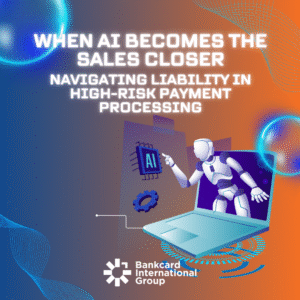TL;DR: AI is no longer just assisting—it’s selling. As AI tools begin closing sales and processing payments, high-risk merchants face new liability challenges. From chargebacks to compliance gaps, understanding who’s responsible when AI drives the transaction is critical. This blog breaks down the risks, offers practical strategies to protect your business, and outlines how merchants and processors can work together to adapt underwriting and liability frameworks for high risk payment processing. If you’re in a high-risk industry using or exploring AI-driven sales, now is the time to get ahead of the curve.
But behind the curtain of this new AI-powered sales journey lies a very real—and very complicated—question:
Who’s responsible if there is a dispute?
Welcome to the new frontier of AI-driven commerce. Conversations—not just clicks—are now closing sales. For high-risk industries like CBD, Firearms, adult entertainment, nutraceuticals, and subscription services, this shift presents both a massive opportunity and a significant compliance challenge.
At Bankcard International Group, we work at the intersection of innovation and risk. And in this post, we’re diving into the growing role of AI in high risk payment processing, what it means for liability, and what you can do to protect your business.
 AI Is No Longer Just Support—It’s the Sales Engine
AI Is No Longer Just Support—It’s the Sales Engine
We’re in a pivotal moment where AI tools like ChatGPT, Meta AI, and proprietary conversational platforms are transitioning from back-office support to front-line sales. Today’s AI can:
- Handle product recommendations
- Respond to objections
- Build cart value through conversation
- And even complete checkout—all without human intervention
That means the classic model—where merchants fully control the sales funnel—has changed. In the traditional environment:
- The merchant owns the website and user journey
- Underwriters assess marketing, chargeback ratios, and fulfillment
- Customers know who they’re buying from
Now? AI sits between the customer and the brand. It might recommend products, answer pre-sale questions, and complete the transaction—all without the customer ever landing on the merchant’s website.
The Risk Amplifier for High Risk Payment Processing Verticals
For businesses already operating in high-risk categories, this is a double-edged sword. AI can drive conversions and expand reach—but it also introduces new layers of complexity when it comes to liability, compliance, and underwriting.
Why High Risk Payment Processing Is Already Complicated
In high risk industries, liability is always top of mind.
Payment processors must navigate:
- Higher chargeback ratios
- Regulatory scrutiny
- Fraud risk
- Reputation management
Meanwhile, merchants are responsible for:
- Accurate product descriptions
- Delivery timelines
- KYC/AML compliance
- Resolving disputes quickly
These relationships rely on clear attribution and accountability. But when an AI owns the customer interaction—making promises or completing payments—who’s actually responsible if something goes sideways?
Who’s Liable When AI Controls the Sale?
It’s tempting to say, “The merchant is always responsible.” And yes, the merchant of record typically owns the financial liability for chargebacks or compliance violations.
But as AI takes a more autonomous role in the transaction, that line starts to blur.
Let’s break down a few realistic scenarios:
Misrepresentation
Ava, the AI assistant, overhypes a product or omits crucial terms. The customer feels deceived and disputes the charge. Is the merchant liable? The AI developer? Or the payment processor?
Compliance Failures
The AI skips or fails to perform proper identity verification, putting the transaction out of compliance with AML or KYC laws. Is the merchant at fault—or does the platform that failed to trigger verification share that burden?
Black Box Problems
AI decision-making often happens in a “black box.” If no audit trail exists, it becomes difficult to prove what was said, promised, or agreed upon during the sale. This lack of transparency can be a nightmare during chargeback disputes or regulator audits.
Contracts, Controls, and Clarity: Your Best Defense in High Risk Payment Processing
In this new paradigm, businesses need to proactively define ownership of risk. That means creating safeguards at every level of the relationship between merchants, AI vendors, and payment processors.
 Here’s where to start:
Here’s where to start:
1. Create Smart Contracts
Define liability clearly. Who is responsible for misrepresentations made by the AI? Who owns compliance enforcement? What happens in the event of a disputed transaction or legal claim?
Well-structured indemnity clauses and service level agreements (SLAs) can prevent surprises.
2. Demand Transparency and Auditability
Can your team pull transcripts of conversations or logs of AI-generated recommendations? Do you have access to the same “proof” a customer or regulator would demand?
Make audit trails mandatory in your vendor requirements.
3. Establish Compliance Protocols
Don’t assume the AI is doing proper customer vetting. Spell out who owns AML/KYC responsibilities and how they’re executed. Document every step, especially if AI is part of the workflow.
4. Use Control Systems
Just as you’d put velocity checks or fraud filters on your gateway, apply oversight to AI-driven transactions. That could include human review thresholds, transaction amount caps, or logic triggers that pause purchases based on risk indicators.
AI Can Catch Fraud… and Also Cause It. A High Risk Payment Processing Problem
Let’s be clear—AI is a powerful tool in fraud detection. Machine learning models can:
- Spot unusual behavior in real time
- Predict chargebacks based on transaction metadata
- Improve authentication with biometrics or behavioral analysis
But fraudsters are getting smarter, too. AI can also be used to:
- Create deepfakes and synthetic identities
- Power automated phishing bots
- Evade traditional fraud filters with dynamic tactics
For high risk merchants, this means doubling down on layered security—both in front of and behind the sale.
Payment Processors Must Evolve: Underwriting AI into the Equation
At Bankcard International Group, we believe that AI should be underwritten just like any other mission critical tool in the payment stack.
 Processors and ISOs must start asking:
Processors and ISOs must start asking:
- What guardrails are in place for the AI platform?
- Is there oversight or the ability to override?
- Can the merchant access conversation logs for disputes?
- Is the AI PCI compliant?
- Does it integrate with AML/KYC tools?
The underwriting process must now account not just for what’s being sold—but how it’s being sold, especially if AI sits at the point of conversion.
What Merchants Should Do Right Now
You don’t need to fear the rise of AI-powered checkouts—but you do need a plan to stay compliant and protected.
Here’s your checklist:
- Audit your AI partners. Make sure you understand how their tools work—and where their liability ends.
- Define risk-sharing clearly. Work with legal counsel to update contracts and include indemnity clauses.
- Ensure visibility. Demand access to AI interaction data and transcripts.
- Stay proactive. Work closely with your payment processor (like BIG) to flag new technologies early.
- Educate your team. Make sure your staff understands the AI’s role and limitations in customer engagement and sales.
Shape the Future—Safely
AI is no longer just a tool—it’s becoming the salesperson. That means the rules of engagement for high-risk payment processing must evolve accordingly.
At BIG, we don’t just help you process payments—we help you future-proof your business. As commerce gets smarter, we believe in helping high-risk businesses stay resilient, compliant, and ahead of the curve.
Let’s start the conversation:
- Would you trust an AI to close sales on your behalf?
- How should liability be handled when machines take the lead?
- What controls are you putting in place to safeguard your brand?
Drop your thoughts in the comments or reach out to our team directly. We’re here to help you navigate the future of AI-driven commerce—with confidence and clarity.







